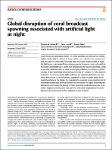Global disruption of coral broadcast spawning associated with artificial light at night
| dc.contributor.author | Davies, T | |
| dc.contributor.author | Tidau, S | |
| dc.date.accessioned | 2023-04-13T14:12:50Z | |
| dc.date.available | 2023-04-13T14:12:50Z | |
| dc.date.issued | 2023 | |
| dc.identifier.issn | 2041-1723 | |
| dc.identifier.issn | 2041-1723 | |
| dc.identifier.other | 2511 | |
| dc.identifier.uri | https://pearl.plymouth.ac.uk/handle/10026.1/20671 | |
| dc.description | File replaced (gold OA version) on 17.5.23 by NK (LDS) | |
| dc.description.abstract |
Coral broadcast spawning events - in which gametes are released on certain nights predictably in relation to lunar cycles - are critical to the maintenance and recovery of coral reefs following mass mortality. Artificial light at night (ALAN) from coastal and offshore developments threatens coral reef health by masking natural light:dark cycles that synchronize broadcast spawning. Using a recently published atlas of underwater light pollution, we analyze a global dataset of 2135 spawning observations from the 21st century. For the majority of genera, corals exposed to light pollution are spawning between one and three days closer to the full moon compared to those on unlit reefs. ALAN possibly advances the trigger for spawning by creating a perceived period of minimum illuminance between sunset and moonrise on nights following the full moon. Advancing the timing of mass spawning could decrease the probability of gamete fertilization and survival, with clear implications for ecological processes involved in the resilience of reef systems. | |
| dc.format.extent | 2511- | |
| dc.format.medium | Electronic | |
| dc.language | en | |
| dc.publisher | Nature Research | |
| dc.subject | Animals | |
| dc.subject | Anthozoa | |
| dc.subject | Light Pollution | |
| dc.subject | Coral Reefs | |
| dc.subject | Photoperiod | |
| dc.subject | Moon | |
| dc.subject | Light | |
| dc.title | Global disruption of coral broadcast spawning associated with artificial light at night | |
| dc.type | journal-article | |
| dc.type | Article | |
| plymouth.author-url | https://www.ncbi.nlm.nih.gov/pubmed/37188683 | |
| plymouth.issue | 1 | |
| plymouth.volume | 14 | |
| plymouth.publication-status | Published online | |
| plymouth.journal | Nature Communications | |
| dc.identifier.doi | 10.1038/s41467-023-38070-y | |
| plymouth.organisational-group | |Plymouth | |
| plymouth.organisational-group | |Plymouth|Faculty of Science and Engineering | |
| plymouth.organisational-group | |Plymouth|Faculty of Science and Engineering|School of Biological and Marine Sciences | |
| plymouth.organisational-group | |Plymouth|REF 2021 Researchers by UoA | |
| plymouth.organisational-group | |Plymouth|Users by role | |
| plymouth.organisational-group | |Plymouth|Users by role|Academics | |
| plymouth.organisational-group | |Plymouth|REF 2021 Researchers by UoA|UoA07 Earth Systems and Environmental Sciences | |
| plymouth.organisational-group | |Plymouth|Users by role|Researchers in ResearchFish submission | |
| dc.publisher.place | England | |
| dcterms.dateAccepted | 2023-04-13 | |
| dc.date.updated | 2023-04-13T14:12:49Z | |
| dc.rights.embargodate | 2023-5-18 | |
| dc.identifier.eissn | 2041-1723 | |
| dc.rights.embargoperiod | forever | |
| rioxxterms.versionofrecord | 10.1038/s41467-023-38070-y |


